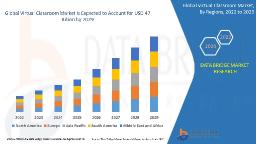

The virtual classroom market refers to the rapidly growing sector of digital platforms that enable live, interactive teaching and learning through the internet. Think of it as a real-time classroom—just online. These platforms offer features like video conferencing, digital whiteboards, chat rooms, and assessment tools, allowing students and instructors to engage from anywhere in the world.
The shift towards remote learning and online education is no longer a temporary pandemic solution. It’s now a cornerstone of modern education systems and corporate training programs. With the right tools and infrastructure, virtual classrooms provide a flexible, scalable, and efficient way to deliver quality learning experiences.
Several factors are fueling this growth:
Increased Internet Penetration: Over 5 billion people are now online, with most using smartphones. This global connectivity makes digital learning accessible to more people than ever.
Rise in E-Learning Demand: Schools, colleges, and companies are actively adopting e-learning platforms to support both formal education and professional development.
Remote Work Culture: As businesses embrace hybrid work models, virtual training becomes essential for onboarding, compliance, and upskilling.
EdTech Investment Surge: Billions of dollars are pouring into EdTech startups innovating in this space, improving user experience and driving adoption.
The global virtual classroom market was valued at around USD 11 billion in 2022 and is expected to grow at a 13% CAGR, reaching nearly USD 30 billion by 2030.
North America leads in adoption thanks to advanced infrastructure and strong EdTech players like Zoom, Google, and Microsoft.
Asia-Pacific is the fastest-growing region, with booming populations and increasing digital access in countries like India, China, and Indonesia.
Europe follows with robust government initiatives and strong regulatory frameworks such as GDPR, which push secure virtual learning adoption.
Latin America and Africa show great potential but still face challenges related to infrastructure and digital literacy.
The market can be broken down into various segments:
Cloud-Based: Popular for flexibility, scalability, and low setup costs.
On-Premises: Preferred by large institutions with specific security or customization needs.
K-12 Education: Embraces gamified, interactive solutions for younger learners.
Higher Education: Uses virtual classrooms for distance degrees, labs, and seminars.
Corporate Training: Businesses use these platforms for employee training, onboarding, and certification.
Software: Learning Management Systems (LMS), conferencing apps, analytics tools.
Hardware: Laptops, tablets, cameras, and smart boards.
Services: Tech support, customization, consulting, and content creation.
Mobile-first platforms and the rollout of 5G technology are enabling high-quality video streaming, real-time collaboration, and interactive experiences even in rural areas.
AI is revolutionizing how students learn. Tools that use machine learning offer personalized learning paths, automate assessments, and provide real-time feedback.
Modern platforms are adding features like badges, leaderboards, and rewards to keep students motivated and reduce dropout rates—especially in K-12.
These technologies create immersive experiences, like virtual science labs or historical site tours, enhancing the learning process significantly.
One of the major hurdles is unequal access to reliable internet and devices. Many students in low-income or rural areas lack the tools to fully participate in digital learning.
With platforms collecting personal data, ensuring GDPR or COPPA compliance and preventing cyberattacks is crucial. Data leaks or unauthorized access can severely damage trust.
Keeping students engaged online is difficult. Without in-person interaction, many struggle with motivation and participation. Solutions include interactive content, live quizzes, and AI-based engagement monitoring.
Key players in the market include:
Google Classroom
Microsoft Teams
Zoom
Blackboard
Moodle
Coursera & Udemy (for professional learning)
These companies continue to invest in AI, language support, integrations with other tools, and security features to stay competitive.
Looking ahead, the market is expected to evolve in several key ways:
EdTech Startups will bring more innovative, localized solutions for underserved regions.
Hybrid Learning Models will become the standard across all levels of education.
Personalized Learning driven by AI and analytics will redefine the student experience.
Government and NGO Partnerships will focus on bridging the digital gap and training educators.
The virtual classroom market is transforming education and professional training across the globe. With rising demand, rapid innovation, and growing investment, this space is set to explode in the coming years. However, it’s not without its challenges—from infrastructure gaps to cybersecurity concerns.
To succeed in this evolving landscape, companies and educators must focus on accessibility, engagement, and data security. The future of learning is not just digital—it’s immersive, inclusive, and intelligent.
Get More Details : https://www.databridgemarketresearch.com/reports/global-virtual-classroom-market
Get More Reports :
https://www.databridgemarketresearch.com/reports/europe-construction-management-software-market
https://www.databridgemarketresearch.com/reports/middle-east-and-africa-antibody-drug-conjugates-market
https://www.databridgemarketresearch.com/reports/europe-safety-systems-market
https://www.databridgemarketresearch.com/reports/global-ev-charging-card-market
https://www.databridgemarketresearch.com/reports/us-construction-management-software-market
| No comments yet. Be the first. |